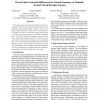Free Online Productivity Tools
i2Speak
i2Symbol
i2OCR
iTex2Img
iWeb2Print
iWeb2Shot
i2Type
iPdf2Split
iPdf2Merge
i2Bopomofo
i2Arabic
i2Style
i2Image
i2PDF
iLatex2Rtf
Sci2ools
104
Voted
HAPTICS
2007
IEEE
2007
IEEE
Towards Just Noticeable Differences for Natural Frequency of Manually Excited Virtual Dynamic Systems
This paper explores the experiment design to determine a human’s ability to discriminate the natural frequency of manually excited virtual dynamic systems. We use a one degree-of-freedom haptic interface with a coupled graphical display to render a virtual mass-spring system, which is excited by the human operator using his/her dominant hand. The results from the preliminary experiment indicate a JND value of approximately 8%. However, results also indicate that excitation strategies have a significant effect on the discrimination threshold determination of this dynamic property. In this paper, along with a discussion of the preliminary results, a refined experiment design that accounts for different factors influencing the discrimination of manually excited natural frequency is presented.
Excited Natural Frequency | HAPTICS 2007 | Natural Frequency | Virtual Dynamic Systems | Virtual Reality |
| Added | 02 Jun 2010 |
| Updated | 02 Jun 2010 |
| Type | Conference |
| Year | 2007 |
| Where | HAPTICS |
| Authors | Yanfang Li, Volkan Patoglu, Deborah Huang, Marcia Kilchenman O'Malley |
Comments (0)

